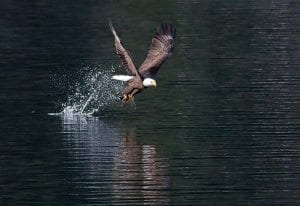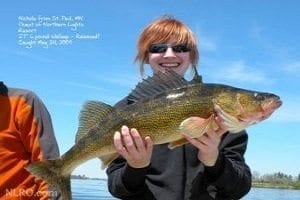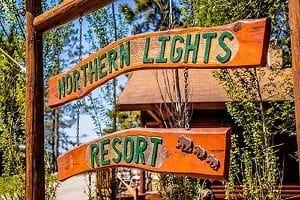Hiking & Birding in Voyageurs National Park
Voyageurs National Park is a top destination for both hiking & birding in Minnesota and the Midwest.
With over 240 species of our feathered friends that call Voyageurs National Park their home, you have one of the richest diversity of bird life in North America right outside your cabin door here on Lake Kabetogama.
One of the most comprehensive hiking guides also notes the birds that can be found in those areas. So we recommend you checkout this birding map for a good overview of our area’s hiking trails too. We list a few of our favorite Voyageurs National Park hiking trails.
Where to hike and see the birds in and near Voyageurs National Park?
- We highly recommend the Voyageurs Area Birding Guide. The list also includes a nice hiking map and tips for seeing the birds in the Voyageurs National Park and surrounding area.
- Refer to Voyageurs Birding Checklist and guide with over 300 bird species that either nest or migrate through the area.
Your bird watching checklist in the Voyageur’s area includes:
- Bald Eagles
- Loons
- Woodpeckers
- Osprey
- White Pelicans
- Hummingbirds
- Owls – Barred, Great grey, and more!
- Many songbirds
Each Season brings fresh birding opportunities in Voyageurs National Park
Spring brings nesting birds to the north woods and lake areas
- Within Voyageurs National Park there are over 70 active Bald Eagle’s Nests. Steve & Tracy will share bird viewing tips. Ask us, we’ve been there!
- If you are looking specifically for nests, nearly 160 different species may be found including 23 of the wood warblers!
- Each spring, here at our forested resort on Kabetogama lake, we usually have several song-bird nests including robins bouncing around catching worms for their chirping babies. New life emerging is a beautiful sight to behold!
The Call of the Loon
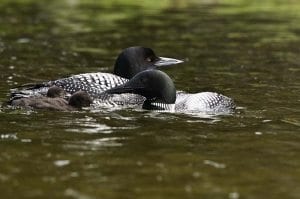
Loons taking care of their of two young babies.
The Loon mates for life and is the state bird. In the spring it’s not uncommon to see the parents swimming with their young on their back! Loons swim and fish in our bay right off the dock of our lakeside lodge every day here on Lake Kabetogama. You will be relaxing in your cabin or around the fire ring near the water’s edge and often at dusk you will hear the hauntingly beautiful call of the loon. It is an unforgettable experience of being “up north” that you won’t want to miss!
Spring, summer and fall offer the greatest opportunities to see birds
Because of the summer migrants, some unusual and interesting birds you might see or hear during those seasons are: Spruce Grouse, Sandhill Crane, Northern Goshawk, Black-backed Woodpecker, Olive-sided or Yellow-bellied Flycatchers, Gray Jay, Boreal Chickadee, Winter Wren, Tennessee, Palm, Bay-breasted, Connecticut or Canada Warblers, Northern Water Thrush, and Indigo Bunting.
Fall migration of birds doubles our sight seeing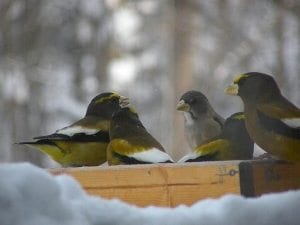
In the fall, the migrating birds bring a different sound to our forested lake area of Voyageurs National Park. The honking of the Canadian geese while flying overhead the colorful autumn colored trees and the call of the Trumpeter Swans is much anticipated.
Northern Lights Resort guests had the pleasure to view a pair of migrating trumpeter swans visiting our bay in the fall and they were so graceful to watch. The same week a family of Trumpeter Swans was spotted on Lake Kabetogama in Lost Bay by Steve & Tracy. Watching very protective bird parents, we paused to see papa swan split from mama and the babies to lure us away. All the while honking like the traffic in NYC! We sat calmly in our boat and watched as he flew overhead and looped back around to join his family again with peaceful tranquility restored.
It’s these ring-side-seats near wildlife that are amazing lifetime memories made while vacationing with your family and friends. While Voyageurs National Park and Lake Kabetogama are the edge of Minnesota wilderness, you vacation with all the comforts of home in your cozy lakeside cabin.
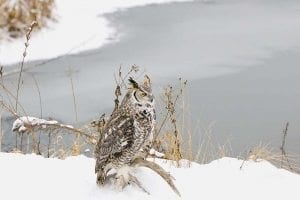 Winter brings the Wise Owls to Voyageurs National Park
Winter brings the Wise Owls to Voyageurs National Park
Winter can be a great time to come also, particularly if there is an influx of Great Gray, Boreal, Snowy or Hawk Owls. Other good winter species include Red or White-winged Crossbills, Pine or Evening Grosbeaks, and Bohemian Waxwing. Voyageurs National Park is actually considered a “southern” destination for some artic bird varieties.
What makes the Voyageurs National Park region so great for birding and rich in biodiversity?
- There are four unique ecological areas (known as subsections) covered by the Voyageurs Area birding guide.
- Each of these subsections will have certain birds that are strongly associated with the varied habitats unique to them. Our four areas include: highlands, lowlands and bog areas, glacial carved rocky areas, chain of lakes and several distinct forests with varied collection of trees & vegetation.
- An Ecological Classification System (ECS) delineates unique land-based areas on their soils, geology, vegetation and other features.
About our Border Lakes Subsection Ecology
- Our property in the heart of Voyageurs National Park connects with Canada and into the Boundary Water Canoe Area (BWCA) by bordering Canada. We are aptly named the Border Lakes Subsection.
- Dominated by rock ridges of glacially-eroded bedrock with many lakes and rivers throughout and contains forests of white, red and jack pine on the better-drained sand and gravel soils.
- Mixed forests of aspen, paper birch, white spruce and balsam fir can be found on the more poorly drained clay soils. There is a unique mix of hardwoods, maples and oak, that makes for a stunning backdrop for birding especially in the fall!
- For birding and hiking maps and a full description of the other 3 distinct ecological areas, refer to the “Bogs to Rocks” birding guide.

